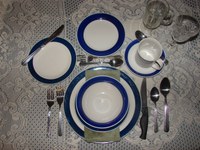Prairie Fare: Table Etiquette 101
(Click an image below to view a high-resolution image that can be downloaded)
By Julie Garden-Robinson, Food and Nutrition Specialist
NDSU Extension Service
“Mom, just because they put it on your plate doesn’t mean you have to eat it,” my 12-year-old commented as we sat at a table at a culinary college in another state.
Every time I finished a slice of fresh bread, one of the attentive culinary students placed another slice on my plate. I finally asked them to remove the plate.
My husband, our daughters and I were having fun in a fancy student-run restaurant complete with white linen tablecloths and napkins, but without the fancy price tag. Our daughters giggled when the students arrived with the small table-cleaning brush to remove the bread crumbs. We don’t have that type of tool in our home.
Only one item did not agree with my palate during our three-course meal. A student came by with a platter of beautiful appetizers, but she was very soft-spoken and I did not catch what she said when she placed one on my plate. It had a base of bread, a tan-colored filling and some tiny pieces of chopped beet on top.
“What did she say this is?” I asked my husband quietly.
“I have no idea,” he replied. We both took a bite simultaneously.
I wish I could have seen the grimace on my face because my family laughed. We still didn’t know what we ate.
I asked the next attentive student who came by with our soup course.
“That was duck foie gras,” he replied.
I recognized the term. I had just eaten the pureed liver of a fattened duck, and it is considered a delicacy to some.
Spoiler alert: Duck liver will not be featured in a recipe in this column now or ever.
Having taught many food classes, I was entertained by the instructors walking by to check if the students had placed the utensils properly on the table. The students served from the left and removed plates from the right.
Class was in session around us and we also were instructing our daughters about table etiquette.
“We should have dressed up for lunch,” our older daughter commented. She and her sister were dressed in shorts and T-shirts because this was a spur-of-the-moment plan.
Our daughters were studying us carefully, so I was trying to be on my best behavior. My elbows never touched the table.
I put my napkin in my lap, and they dutifully followed suit. This was fun, sort of like a pantomime version of “Simon says.”
We had an entire lineup of utensils to use and a variety of glasses, which was more complicated than the average meal in the Robinson household.
“Just work from the outside to the center when you are using the utensils,” my husband noted.
“The salad fork is on the left side farthest from the plate and the dinner fork is closer to the plate,” I added in a quiet voice. “Your soup spoon is the farthest utensil on the right. Be sure to scoop your soup away from you and don’t slurp.”
We had a “dining experience” as we enjoyed our meal. Eating more slowly allows time to enjoy food and provides an opportunity for your brain and stomach to connect. I cut a couple of bites from my roasted chicken and asparagus main course.
Mealtime etiquette varies a bit depending on where you live. According to some standard meal etiquette rules, the napkin stays in your lap until the end of the meal and then gets placed to the left of the plate. You do not need to refold it.
Using a cellphone at the table is considered bad etiquette, so I curbed my desire to do some quick checking about etiquette.
The way that forks and knives are managed at the table varies by location. Most people in the U.S. use “American style” handling of knives and forks. When cutting meat, right-handed people hold the fork in their left hand and cut with their knife with their right hand. Then they swap the position of the utensils to eat.
In “continental style” dining, the fork remains in the left hand, tines down, and the knife in the right hand. You do not switch hands, and you do not set your utensils down.
To me, this would be like eating “left handed,” which might be a good diet plan because the food would fall off the fork before reaching my mouth. I probably wouldn’t starve. In continental style, when you need a drink of water, you put both utensils down, crossing the knife over the fork.
I could not remember the exact position the knife and fork needed to be on my plate to signal we were done. I looked over my shoulder at the people at the next table and followed their lead. Their utensils seemed to be at about the 4:20 position, if you think of plates as a clock face. (They knew what they were doing.)
Signaling you are “resting” before continuing to eat can be shown in many ways, but the knife and fork are kept on the plate.
If you like to host fancy dinner parties, you can find “rules” in many cookbooks, especially older cookbooks with an entertaining guide. For example, passing the salt and pepper together is a good rule. Technically, you should not salt and pepper food without tasting it first.
I recommend having a dining experience now and then. Here’s a recipe fairly similar to my main course at the culinary school.
Rosemary Roasted Chicken
1 (3-pound) whole chicken
Salt and pepper (as desired)
1 small onion, quartered
1/4 c. chopped fresh rosemary
Preheat oven to 350 F. Season the chicken with salt and pepper as desired. Stuff the cavity with rosemary and onion. Place in a roasting pan or large baking dish. To prevent drying out and browning, you may want to cover the chicken loosely with aluminum foil. Roast for two to 2 1/2 hours, until juices run clear and the internal temperature is 165 F. Baste the chicken a couple of times during roasting with the juices in the pan.
A 3-ounce portion of roasted chicken (about the size of a deck of cards) without skin and without added salt has 150 calories, 7 grams (g) fat, 20 g protein, 0 g carbohydrate, 0 g fiber and 80 milligrams sodium.
(Julie Garden-Robinson, Ph.D., R.D., L.R.D., is a North Dakota State University Extension Service food and nutrition specialist and professor in the Department of Health, Nutrition and Exercise Sciences.)
NDSU Agriculture Communication - June 30, 2016
| Source: | Julie Garden-Robinson, 701-231-7187, julie.garden-robinson@ndsu.edu |
|---|---|
| Editor: | Ellen Crawford, 701-231-5391, ellen.crawford@ndsu.edu |



